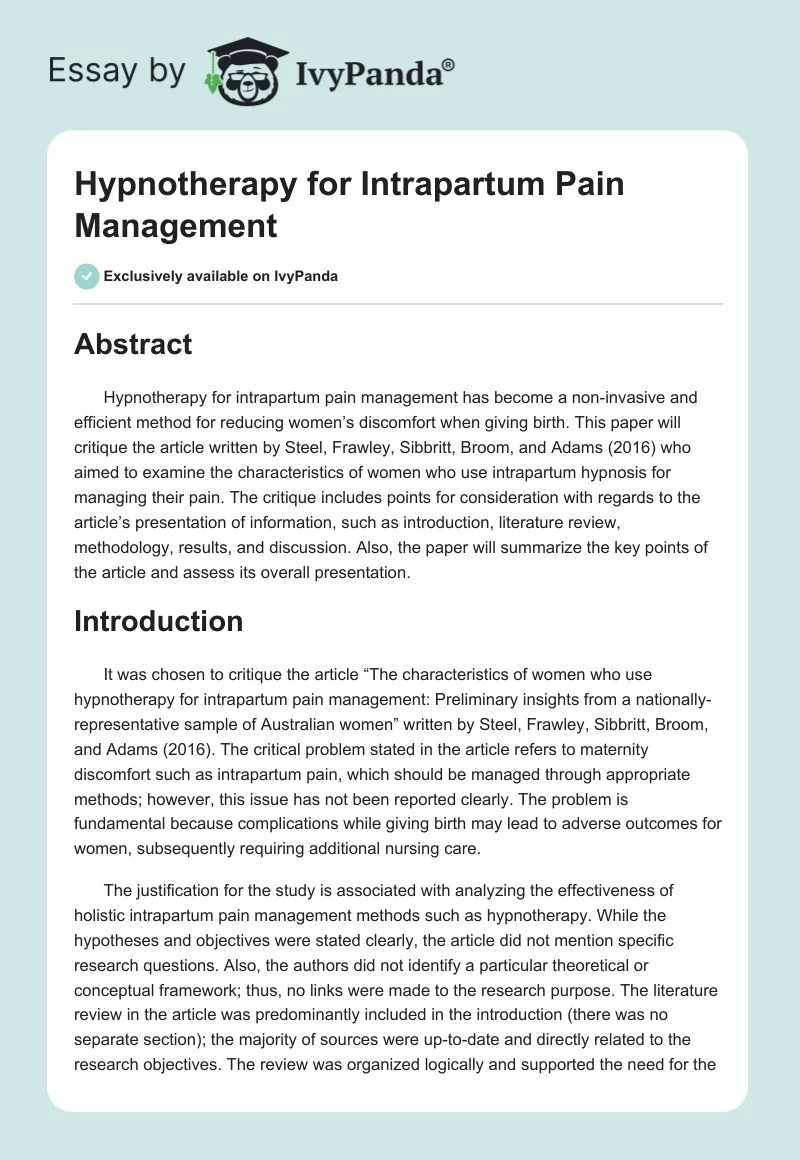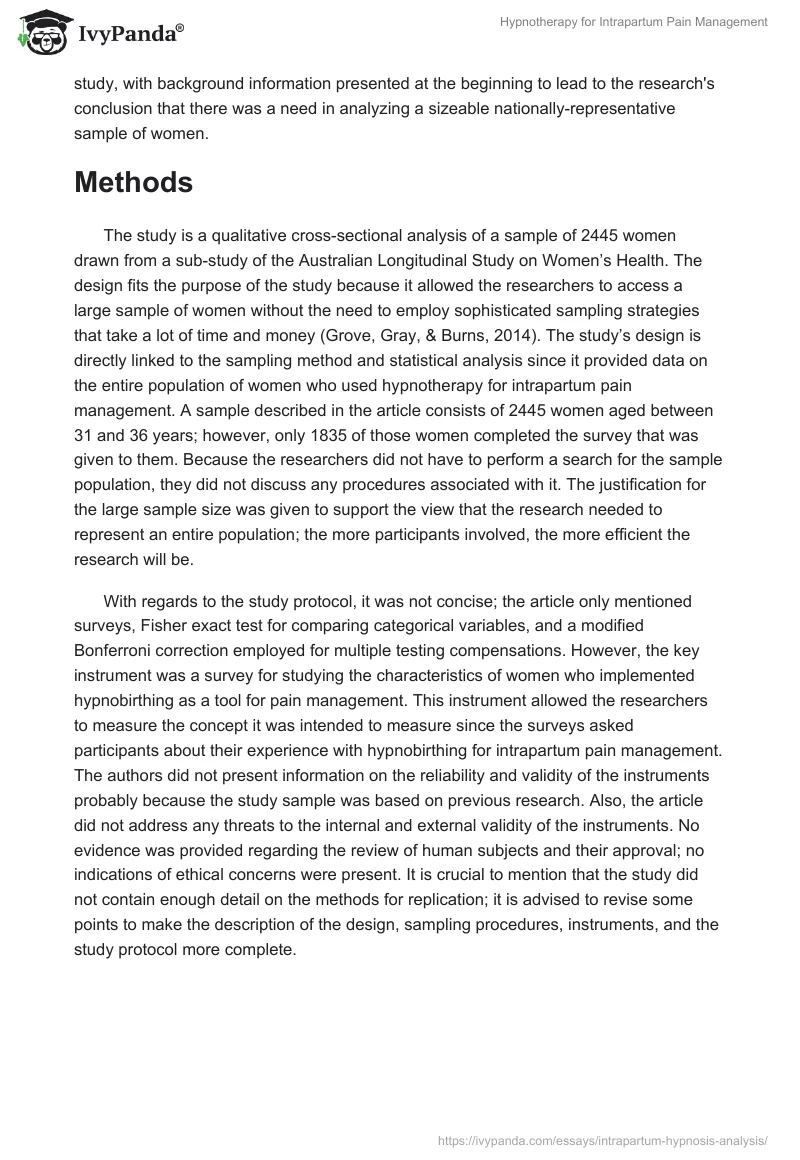Abstract
Hypnotherapy for intrapartum pain management has become a non-invasive and efficient method for reducing women’s discomfort when giving birth. This paper will critique the article written by Steel, Frawley, Sibbritt, Broom, and Adams (2016) who aimed to examine the characteristics of women who use intrapartum hypnosis for managing their pain. The critique includes points for consideration with regards to the article’s presentation of information, such as introduction, literature review, methodology, results, and discussion. Also, the paper will summarize the key points of the article and assess its overall presentation.
Introduction
It was chosen to critique the article “The characteristics of women who use hypnotherapy for intrapartum pain management: Preliminary insights from a nationally-representative sample of Australian women” written by Steel, Frawley, Sibbritt, Broom, and Adams (2016). The critical problem stated in the article refers to maternity discomfort such as intrapartum pain, which should be managed through appropriate methods; however, this issue has not been reported clearly. The problem is fundamental because complications while giving birth may lead to adverse outcomes for women, subsequently requiring additional nursing care.
The justification for the study is associated with analyzing the effectiveness of holistic intrapartum pain management methods such as hypnotherapy. While the hypotheses and objectives were stated clearly, the article did not mention specific research questions. Also, the authors did not identify a particular theoretical or conceptual framework; thus, no links were made to the research purpose. The literature review in the article was predominantly included in the introduction (there was no separate section); the majority of sources were up-to-date and directly related to the research objectives. The review was organized logically and supported the need for the study, with background information presented at the beginning to lead to the research’s conclusion that there was a need in analyzing a sizeable nationally-representative sample of women.
Methods
The study is a qualitative cross-sectional analysis of a sample of 2445 women drawn from a sub-study of the Australian Longitudinal Study on Women’s Health. The design fits the purpose of the study because it allowed the researchers to access a large sample of women without the need to employ sophisticated sampling strategies that take a lot of time and money (Grove, Gray, & Burns, 2014). The study’s design is directly linked to the sampling method and statistical analysis since it provided data on the entire population of women who used hypnotherapy for intrapartum pain management. A sample described in the article consists of 2445 women aged between 31 and 36 years; however, only 1835 of those women completed the survey that was given to them. Because the researchers did not have to perform a search for the sample population, they did not discuss any procedures associated with it. The justification for the large sample size was given to support the view that the research needed to represent an entire population; the more participants involved, the more efficient the research will be.
With regards to the study protocol, it was not concise; the article only mentioned surveys, Fisher exact test for comparing categorical variables, and a modified Bonferroni correction employed for multiple testing compensations. However, the key instrument was a survey for studying the characteristics of women who implemented hypnobirthing as a tool for pain management. This instrument allowed the researchers to measure the concept it was intended to measure since the surveys asked participants about their experience with hypnobirthing for intrapartum pain management. The authors did not present information on the reliability and validity of the instruments probably because the study sample was based on previous research. Also, the article did not address any threats to the internal and external validity of the instruments. No evidence was provided regarding the review of human subjects and their approval; no indications of ethical concerns were present. It is crucial to mention that the study did not contain enough detail on the methods for replication; it is advised to revise some points to make the description of the design, sampling procedures, instruments, and the study protocol more complete.
Results
When it comes to the characteristics of the sample, the researchers suggested that there were no socio-demographic differences in the study sample of women who used hypnobirthing and those who did not. Since there was only one hypothesis developed in the research, it was answered separately in the results section. Data collected during the research was qualitative and referred to women’s experiences with hypnobirthing as an intrapartum pain management tool. Fisher exact tests were used for the comparison of categorical variables within the study population; however, the researchers did not describe specific data analysis procedures used for answering study questions. The article included a table, which presented differences between women who used hypnotherapy as a pain management tool for labor and women who did not. The text of the article supplemented the data in the tables and was more descriptive while the table included quantitative data on 54 women who used hypnobirthing and 1294 that did not.
Steel et al. (2016) found that women who used hypnotherapy for intrapartum pain management were more likely to consult holistic specialists such as acupuncturists or naturopaths and take meditation or yoga classes. Also, these women were more inclined to practice holistic therapy. It is important to mention that the use of hypnotherapy was directly related to women’s place of giving birth due to the need for certain environmental requirements for performing a successful procedure for managing pain. If to analyze the findings of the research, the collected information should not be used as a definite conclusion on the use of hypnotherapy but rather a preliminary set of data for further research since the study can be considered incomplete and indefinite.
Discussion
When presenting a section on the discussion, the authors make direct connections between the findings and the objectives of the study. Since the sample and preliminary data were drawn from the Australian Longitudinal Study on Women’s Health, the results of the research align with the findings of the previous study. The authors did not discuss the findings that conflict with previous work; however, they mentioned that the ALSWH research was restricted and did not represent the entire population of women who would be relevant for analysis in the study.
With regards to the limitations of the study in terms of practice and future research, researchers mentioned that “the findings from this analysis need to be interpreted with caution; despite the nationally representative sample, the cross-sectional study design limits the ability to determine causality between variables” (Steel et al., 2016, p. 68). This suggestion is similar to that given by Downe et al. (2015) who also concluded that further investigation of women’s mental and physical condition during labor was needed. Also, the researchers mentioned that the small number of women who reported using hypnotherapy for pain management during labor was another limitation that impacted the study’s statistical power. While no new research emerged from the study, it is expected that Steel et al. (2016) will continue their studies and overcome the identified limitations for achieving reliable and meaningful results. The potential for use in nursing practice with regards to the findings of the research is associated with educating women about the possible benefits of hypnotherapy as a non-invasive method for managing their pain during delivery. Nurses can provide consultations to future mothers and provide advice on how to combine hypnotherapy with traditional nursing methods targeted at the reduction of intrapartum pain.
Overall Presentation and Summary
When it comes to assessing whether the title accurately describes the type of study, major variables, and the target population, it is essential to mention that the title is long and contains as much key information as it is possible to fit in it. While the type of study (cross-sectional analysis) is not mentioned in the title, the authors included the major variable (characteristics of women who use hypnotherapy for intrapartum pain management) and the target population (Australian women). Also, the abstract accurately represented the article; it included research objectives, design, setting, main outcome measures, results, and conclusions.
By reading the abstract, one can understand the purpose of the study, discover new information to a previously unknown phenomenon, and access brief data on the research findings without the need for reading the entire article, which is the primary purpose of abstracts. The report can be considered logically consistent; the presented information was divided into sections for better navigation throughout the entire article. Overall, the writing style of the article was clear and concise; the information did not contain complicated language, which meant that even individuals without particular knowledge of hypnotherapy and pain management during labor could understand what the researchers wanted to achieve and what results they attained.
References
Downe, S., Finlayson, K., Melvin, C., Spiby, H., Ali, S., Diggle, P., … Williamson, M. (2015). Self-hypnosis for intrapartum pain management in pregnant nulliparous women: A randomised controlled trial of clinical effectiveness. Bjog, 122(9), 1226-1234.
Grove, F., Gray, G., & Burns, S. (2014). Understanding nursing research (6th ed.), New York, NY: Elsevier.
Steel, A., Frawley, J., Sibbritt, D., Broom, A., & Adams, J. (2016). The characteristics of women who use hypnotherapy for intrapartum pain management: Preliminary insights from a nationally-representative sample of Australian women. Complementary Therapies in Medicine, 25, 67-70.


